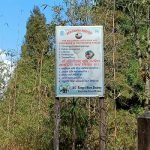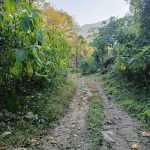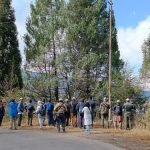The second BWS bird watching camp was organised over five days (December 17 to 21, 2022) near Majua under Darjeeling District of West Bengal. The camp was attended by a total of 26 enthusiastic members covering all age groups from college going students to retired seniors.
After the first camp that was organised in Purulia, the venue for the second camp was carefully chosen to offer a different kind of biosphere in which to observe birds and also to explore a relatively less known birding destination of West Bengal in early winter.
Those who have travelled in the Singalila region of Eastern Himalaya would be familiar with the small town of Manebhanjan (about three hours’ drive from Siliguri) from where the uphill trek for Sandakphu starts. Majua at approximately 6000 feet is a journey of another ten kilometres or so below this town. Administratively, it comes under the Tonglu range of the state forest department.
Birders from different parts of the state congregated at Siliguri’s New Jalpaiguri station on the wintry December morning of 17th and set off for the pleasurable journey through the mixed forests and tea gardens towards Majua. The 15 km drive from Sukhia Pokhari to Majua via Manebhanjan was terribly bumpy but not enough to dampen the enthusiasm of the intrepid BWS members, who have time and again proven their resilience to travel to difficult areas in search of their avian friends.
The birders were put up for the four chilly nights in two different accommodations (“homestays” in today’s tourism parlance) at Majua. One by the main roadside – Aranyabaas which can accommodate up to twenty in different cottages and another at Warbler’s Nest that is less than two kilometres above Aranyabaas.
The bouldered and unpaved road to Warbler’s Nest is quite a challenge to drive even for four-wheel drive vehicles with very high ground clearance. However, it is set up for hardcore birders by another hardcore birder and BWS member and easily accommodated around ten.
Apart from the above par hospitality organised by some of the members themselves, both the locations offered excellent birding opportunities from the campus itself and revealed some gems such as:
Cupwings like Pygmy and Scaly, Large Hawk Cuckoo, Great Barbet, Scarlet Minivet, Long-tailed Minivet, Grey-headed Canary Flycatcher, White-browed Fulvetta, Blue-winged Minla, Red-billed Leothrix, Verditer Flycatcher, Olive-backed Pipit. Chestnut-crowned, White-crested, Spotted and Scaly Laughingthrushes are common. White-tailed Nuthatch is also common; One can findGreen Magpie, Yellow-billed and Red-billed Blue Magpie, Silver-eared Mesia, Black-throated Sunbird etc. etc. . Treecreepers like Rusty-tailed, Sikkim can also be found.
This area, incidentally, is also home to a melanistic leopard, more popularly known as the black panther.
Being a completely non-touristy area with very sparse local population, the pursuit of bird watching happened in a totally undisturbed manner. There was hardly any manmade noise in the vicinity. Weather, which is a major factor in these eastern Himalayan heights, didn’t play truant (despite predictions to the contrary) and offered clear blue skies almost every day.
The highlight of the camp was a trip to Dhotrey on the penultimate day.
The camp ended on the morning of 21st December with a promise by the members to meet once again at the next camp. Where it will be will have to remain a secret for now.
To know more about the camp experience and bird list read our Newsletter Fantail Vol2 Issue3 page 42

























